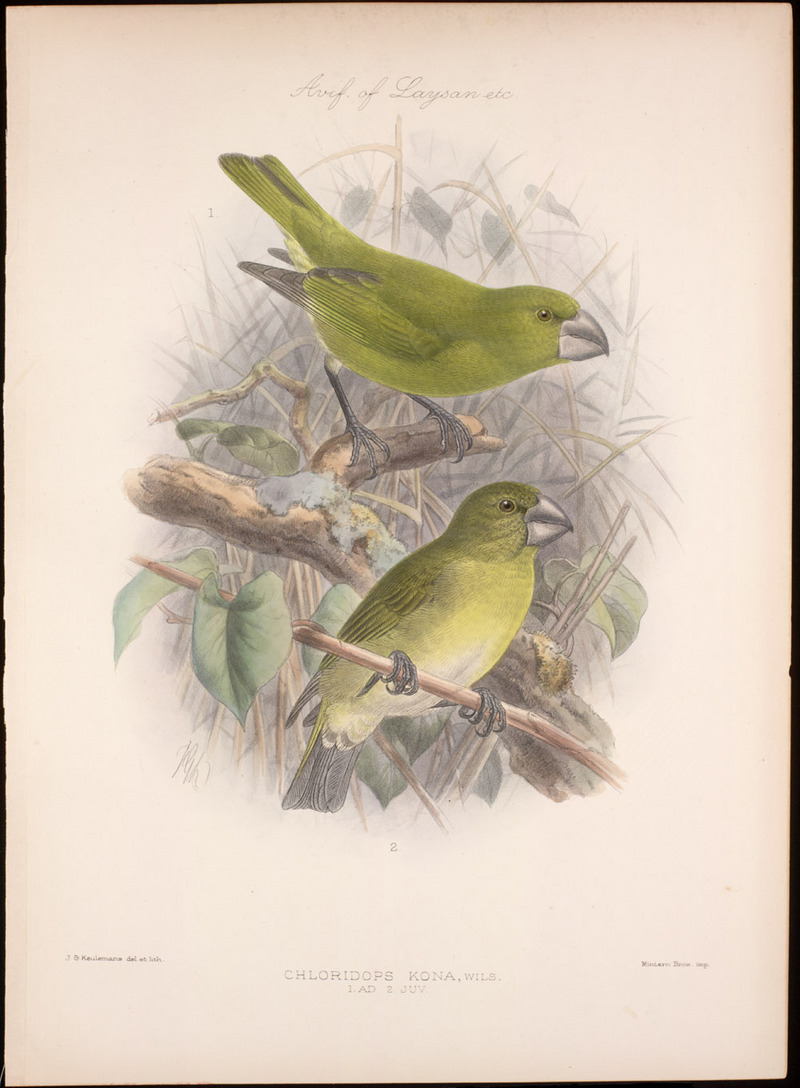Kona Grosbeak (Chloridops kona) - Wiki Kona Grosbeak
From Wikipedia, the free encyclopedia
Order: Passeriformes
Family: Fringillidae
Status: Extinct
[Photo] Kona Grosbeak (Chloridops kona). 1. adult, 2. juvenile. Source: "The Avifauna of Laysan", 1893-1900, Walter Rothschild. URL: http://www.sil.si.edu/digitalcollections/nhrarebooks/rothschild/CF/description-search-results-all.cfm
The Kona Grosbeak (Chloridops kona) was a species of finch in the Fringillidae family. Psittirostra kona was endemic to naio forest on lava flows at 1,000???1,800 m on Hawaii, USA. The species was already very rare when it was first discovered, being found in only about four square miles, and was last collected in 1894. Reasons for its extinction are not very well known. The genus is known from fossils from Kauai, Oahu and Maui. It was endemic to Hawaii. It was already rare when Wilson first visited the island Hawaii, the Kona grosbeak was found at elevations of about 5,000 feet or higher in the Kona district in areas of the koa forest. In 1887, Wilson was one of the last people to be able to see the bird in life, for it was last reliably sighted in 1894. He saw only about three birds on a four-week stay, and it was so rare that the bird apparently had no name in the Hawaiian language. The bulk of Wilson’s report on the Kona grosbeak (also known as the Kona finch or grosbeak finch) is from an excerpt from Robert Perkin’s rather disapproving notes, published in the book, The Ibis in 1893:
The Chloridops kona (Kona grosbeak), though an interesting bird on account of its peculiar structure, is a singularly uninteresting one in its habits. It is a dull, sluggish, solitary bird and very silent-its whole existence may be summed up in the words “to eat.” Its food consists of the seeds of the fruit of the aaka (bastard sandal-tree, and probably in other seasons of those of the sandalwood tree), and as these are very minute, its whole time seems to be taken up in cracking the extremely hard shells of this fruit, for which its extraordinarily powerful beak and heavy head have been developed. I think there must have been hundreds of the small white kernels in those that I examined. The incessant cracking of the fruits when one of these birds is feeding, the noise of which can be heard for a considerable distance, renders the bird much easier to see than it otherwise would be. It is mostly found on the roughest lava, but also wanders into the open spaces in the forest. I never heard it sing (once mistook the young Rhodocanthis’ -greater koa finch song for that of Chloridops), but my boy informed me that he had heard it once, and its song was not like that of Rhodocanthis. Only once did I see it display any real activity, when a male and female were in active pursuit of one another amongst the sandal-trees. Its beak is nearly always very dirty, with a brown substance adherent to it, which must be derived from the sandal-tree.
Bastard Sandal Tree referred to here is more commonly known today as the naio tree (Myoporum sandwicense), which grows primarily on medium-aged lava flows.
http://en.wikipedia.org/wiki/Kona_Grosbeak
| The text in this page is based on the copyrighted Wikipedia article shown in above URL. It is used under the GNU Free Documentation License. You may redistribute it, verbatim or modified, providing that you comply with the terms of the GFDL. |
